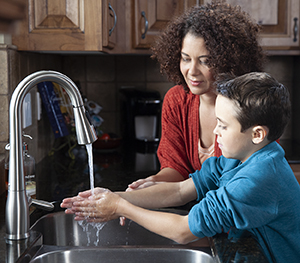Strep Throat
Strep throat is a throat infection caused by a bacteria called group A Streptococcus (group A strep). The bacteria live in the nose and throat. Strep throat spreads easily from person to person through airborne droplets when an infected person coughs, sneezes, or talks. Good handwashing is important to help prevent the spread of this illness. So is not sharing food or drinks.
Strep throat mainly affects school-aged children between ages 5 and 15. But it can affect adults too. Children diagnosed with strep throat shouldn't go to school or daycare until they've been taking antibiotics and been fever-free for 24 hours.
When not treated, strep throat can lead to serious problems. This includes an inflammation of the joints and heart (rheumatic fever). Even with treatment, there can be rare but serious problems after strep. These can include inflammation in the kidneys.
 |
| Washing hands often helps prevent the spread of strep throat. |
How is strep throat spread?
Strep throat can be easily spread from an infected person's saliva in these ways:
-
A sick person coughs or sneezes without covering their mouth
-
Sharing a straw, cup, plate, toothbrush, and eating utensils with someone who is sick.
When to go to the emergency room (ER)
Call 911 if your child has any of these:
Call your child's healthcare provider right away about other symptoms of strep throat, such as:
-
Throat pain, especially when swallowing
-
Red, swollen tonsils
-
Swollen lymph glands
-
A skin rash, called scarlet fever
-
Stomachache and, sometimes, vomiting in younger children
-
Pus in the back of the throat
What to expect at your visit
-
Your child will be examined and the healthcare provider will ask about their health history.
-
The child's tonsils will be examined. A sample of fluid may be taken from the back of the throat using a soft swab. The sample can be checked right away for the bacteria that cause strep throat. Another sample may also be sent to a lab for a throat culture test. This test takes more time but it's more accurate.
-
If your child has strep throat, the healthcare provider will prescribe an antibiotic. It will kill the strep bacteria. Be sure your child takes all the medicine, even if they start to feel better. Antibiotics won't help a viral throat infection.
-
If swallowing is very painful, pain medicine may also be prescribed.
When to call your child's healthcare provider
Call your healthcare provider if your otherwise healthy child has finished the treatment for strep throat and has:
Fever and children
Use a digital thermometer to check your child’s temperature. Don’t use a mercury thermometer. There are different kinds and uses of digital thermometers. They include:
-
Rectal. For children younger than 3 years, a rectal temperature is the most accurate.
-
Forehead (temporal). This works for children age 3 months and older. If a child under 3 months old has signs of illness, this can be used for a first pass. The provider may want to confirm with a rectal temperature.
-
Ear (tympanic). Ear temperatures are accurate after 6 months of age, but not before.
-
Armpit (axillary). This is the least reliable but may be used for a first pass to check a child of any age with signs of illness. The provider may want to confirm with a rectal temperature.
-
Mouth (oral). Don’t use a thermometer in your child’s mouth until they are at least 4 years old.
Use a rectal thermometer with care. Follow the product maker’s directions for correct use. Insert it gently. Label it and make sure it’s not used in the mouth. It may pass on germs from the stool. If you don’t feel OK using a rectal thermometer, ask the healthcare provider what type to use instead. When you talk with any healthcare provider about your child’s fever, tell them which type you used.
Below is when to call the healthcare provider if your child has a fever. Your child’s healthcare provider may give you different numbers. Follow their instructions.
When to call a healthcare provider about your child’s fever
For a baby under 3 months old:
-
First, ask your child’s healthcare provider how you should take the temperature.
-
Rectal or forehead: 100.4°F (38°C) or higher
-
Armpit: 99°F (37.2°C) or higher
-
A fever of ___________as advised by the provider
For a child age 3 months to 36 months (3 years):
-
Rectal or forehead: 102°F (38.9°C) or higher
-
Ear (only for use over age 6 months): 102°F (38.9°C) or higher
-
A fever of ___________ as advised by the provider
In these cases:
-
Armpit temperature of 103°F (39.4°C) or higher in a child of any age
-
Temperature of 104°F (40°C) or higher in a child of any age
-
A fever of ___________ as advised by the provider
Easing strep throat symptoms
These tips can help ease your child's symptoms:
-
Offer easy-to-swallow foods, such as soup, applesauce, ice pops, cold drinks, milk shakes, and yogurt.
-
Provide a soft diet and don't give spicy or acidic foods.
-
Use a cool-mist humidifier in the child's bedroom.
-
Gargle with saltwater (for older children and adults only). Mix 1/4 teaspoon salt in 1 cup (8 oz) of warm water.